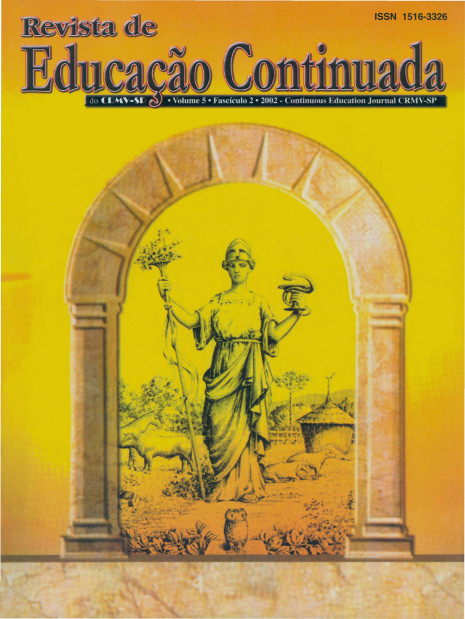Tumores em pele e partes moles de cães - Estudo clínico e cito-histológico
Conteúdo do artigo principal
Resumo
No período de agosto de 1998 a dezembro de 1999,213 cães portadores de 300 tumores em pele e/ou partes moles foram avaliados clinicamente, e o material coletado das lesões, com uma agulha fina (21-270), sem aspiração, foi submetido ao exame citológico. Os esfregaços foram secos ao ar e corados pela técnica de Rosenfeld. Cães com seis anos de idade ou mais (n=159) compreenderam 75%doscasos; 56% (n=119) dos animais eram do sexo masculino e 44% (n=94) do feminino. Animais sem raça definida (SRO) (n=74), seguidos das raças Boxer (n=21), Poodle (n=18), Pastor Alemão (n=15), Cocker Spaniel (n=12) e Doberman (n=ll) foram os mais freqüentes. Quarenta por cento dos cães (85/213) tiveram seus 117 tumores submetidos também ao exame histológico. Foram encontradas 77 lesões benignas (22 não-neoplásicas e 55 neoplásicas) e 40 malignas. Os tumores foram representados por lesões não-neoplásicas (19%), neoplasia epitelial (36%), neoplasia mesenquimal (30%), neoplasia de célula redonda (13%) e neopiasia melanocítica (2%). As lesões não neoplásicas mais freqüentes foram os processos inflamatórios com granuloma tipo corpo estranho (n=9) e os cistos epidérmicos (n=9); dentre as neoplasias benignas, o lipoma (n=14) e o tricoblastoma (n= IO) e, dentre as malignas, o mastocitoma (n= 14) e o hemangiopericitoma (n=9) foram as mais freqüentes. O método citológico demonstrou ser bastante eficaz na avaliaçãode tumores em pele e partes moles. com sensibilidade de 89%, especificidade de 100%. valor preditivo positivo de 100%. valor preditivo negativo de 96%. eficiência de 97% quando comparado ao exame histológico.
Detalhes do artigo
Edição
Seção
1. Autores mantém os direitos autorais e concedem à revista o direito de primeira publicação, com o trabalho licenciado sob a Creative Commons Atribuição-NãoComercial-SemDerivações 4.0 Internacional
2. Autores têm autorização para assumir contratos adicionais separadamente, para distribuição não-exclusica da versão do trabalho publicada nesta revista (ex.: publicar em repositório institucional ou como capítulo de livro), com reconhecimento de autoria e publicação inicial nesta revista.
3. Autores têm permissão e são estimulados a publicar e distribuir seu trabalho online (ex.: em repositórios instituicionais ou na sua página pessoal) a qualquer ponto antes ou durante o processo editorial, já que isso pode gerar alterações produtivas, bem como aumentar o impacto e a citação do trabalho publicado (Veja O Efeito do Acesso Livre);
